#RCA cables
Explore tagged Tumblr posts
Text
Früger Cables & Accessories

Früger Audio Solutions is a leading provider of premium audio and video connectivity solutions. Our extensive range of products includes HDMI cables, speaker wires, RCA cables, and various audio accessories designed to meet the diverse needs of our customers. We pride ourselves on delivering high-quality products that enhance your entertainment experience. Whether you're setting up a home theater system or a professional audio studio, Früger has you covered with reliable connectivity solutions that ensure optimal performance and audio fidelity. Our commitment to excellence drives us to continually innovate and deliver cutting-edge products that exceed expectations. Join us on our journey to revolutionize the world of audio connectivity.
Visit Our Website
0 notes
Text
Best RCA Cables For Car Audio

Best RCA Cables For Car Audio
Installing a quality aftermarket car audio system is a great way to improve the sound of your vehicle. However, in order to get the best performance from your system, it is important to use high-quality components. By using only the best quality parts can help extend the life of your system and prevent any potential damage – this includes even things like the cables being used.
RCA cables are some of the most commonly used cables in-car audio systems. They are used to connect a variety of components, including amplifiers, head units, and subwoofers. There are a number of different RCA cable types available on the market, so it can be tough to know which ones are best for your needs. In this blog post, we will discuss the different types of RCA cables and recommend five of the best options for car audio applications to help you get the most bang for your buck from your system.
What Is An RCA Cable?
An RCA audio cable is a type of cable used to connect audio components. They are also known as phono cables or composite video cables. RCA cables were invented in the 1940s by the Radio Corporation of America (RCA).
The name “RCA” comes from the company’s initials. RCA cables are typically made of copper and have two conductors: a positive conductor (the red wire) and a negative conductor (the white wire).
RCA audio cables are most commonly used to connect turntables to amplifiers, but they can also be used to connect other types of audio components, like CD players and tape decks and are also used in car audio systems.
How Are RCA Cables Used In Car Audio?
RCA cables are used for a variety of things in car audio systems. They can be used to connect an amplifier to your head unit, or they can be used to connect your head unit to a subwoofer. There are also RCA cables that are used to connect two amplifiers together or to connect an amplifier to a set of speakers. In short, RCA cables are versatile and can be used for a variety of purposes in your car audio system.
rca cables for car audio
Are All RCA Cables The Same Quality?
There are different types and qualities of RCA cables, just like any other type of cable. The better the quality, the better the signal it can carry.
When it comes to audio equipment, you want to use the best quality cables you can afford in order to get the best possible signal. Cheap cables can cause all sorts of problems, from interference and static to poor sound quality.
If you’re serious about your car audio setup, invest in good-quality RCA cables. They may cost a bit more upfront, but they’ll save you money and headaches in the long run. Plus, you’ll be able to enjoy your music the way it was meant to be experienced – with crystal clear sound.
best rca cables for car audio
What To Look Out For When Choosing RCA Cables For Car Audio
When it comes to choosing RCA cables for your car audio system, there are a few things you need to keep in mind. Here are the most important factors:
– Length
Length is probably the most important factor when it comes to best 3.5mm audio cable . You want to make sure the cables are long enough to reach from your head unit to your amplifier, but not so long that they’re cumbersome. The standard length for RCA cables is 16 feet (about five meters).
– Connectors
Connectors are another important factor. You want to make sure the connectors are compatible with your head unit and amplifier. The most common type of connector is the phono plug, which has a diameter of about 0.25 inches (0.64 cm).
– Shielding
Shielding is also important in preventing interference from other electronic devices. The most common type of shielding is copper braid, which helps to block electromagnetic interference (EMI).
rca cables for car audio – Conductor Material
Conductor material is also important in determining the quality of an RCA cable. The most common materials are copper and aluminum. Copper is the better conductor, but it is also more expensive. Aluminum is a good conductor, but it is not as good as copper. So, when you’re choosing RCA cables for your car audio system, keep these factors in mind. Length, connectors, shielding, and conductor material are all important in determining the quality of the cable.
What Are Best RCA Cables For Car Audio There are a lot of different types of RCA cables out there. But which ones are the best for car audio? Here, we’ve selected the top five RCA cables for car audio, based on their quality, durability, and price.
Whether you’re looking for the best bang for your buck or the absolute best performance, one of these RCA cables is sure to meet your needs. Let’s take a look at our picks!
RCA Cable: https://bestelectricshop.com/best-rca-cables-for-car-audio/
0 notes
Text
I found a small CRT on the side of the road a month or so ago and as tempted as I may be to gut it to make a robot head 1) it is slightly too big to comfortably be used for that and 2) cleaning all of the caked-on oil-dust grime off the top has made me bond with this lil guy so much that it almost feels mean to take him apart for something so frivolous
#flit chats#kernel space#right now I wanna find an HDMI-RCA cable and use him as a second monitor#developing my robot kink has fundamentally changed how I interact with technology
3 notes
·
View notes
Text


day off secondhand haul. 14$ 1999 mini audio system and a 1938 maths textbook
#edit: happy to report the stereo works like a charm. gotta get a better rca - 3.5 cable though lmao
3 notes
·
View notes
Text
dvd players are like cats they come to you when you least expect them and you need to buy things for them
#txt#i need an rca to hdmi or rca to rca cable. there are none in the house somehow#but there’s a whole ass dvd player i guess
2 notes
·
View notes
Text
This is the happiest cable in the world



#cable#converter#rca#av#jack#audio cable#audio setup#speaker setup#speaker cable#smiley#smiley face#smile#happy#cute#adorbs#awww#awwwww#awwwwwww
0 notes
Text

Fusion RCA Cable - 2 Channel - 12' http://dlvr.it/TFZyvm
0 notes
Text
DVR vs NVR : Qu'est-ce qui est le mieux ? Les avantages et les inconvénients
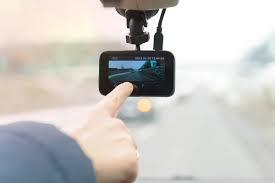
Si vous recherchez un système de vidéosurveillance pour votre entreprise, votre recherche vous conduira vers deux options populaires : Les systèmes DVR (enregistreur vidéo numérique) et les systèmes NVR (enregistreur vidéo en réseau). Lire aussi «Caméra embarquée DVR »
L'option que vous choisirez aura une incidence sur le coût total, la qualité vidéo et la conservation des images. Dans cet article, notre objectif est de vous aider à comprendre les similitudes et les différences entre DVR et NVR : Nous explorerons également une troisième option émergente, lesystème de caméras en nuage.
Une autre option qu'il convient de citer ici est la HD analogique. Vous pouvez obtenir une résolution 720p avec votre système analogique existant sans avoir à recâbler les câbles coaxiaux (vous pouvez simplement les réutiliser pour obtenir une résolution 720p).
Enfin, nous expliquerons comment Solink, notre système de vidéosurveillance en nuage, vous permet d'augmenter les capacités d'un DVR ou d'un NVR sans encourir de coûts élevés.
Les différences entre DVR et NVR
Les enregistreurs vidéo numériques (DVR) et les enregistreurs vidéo sur IP (NVR) sont des types de systèmes d'enregistrement vidéo utilisés pour les caméras de sécurité. �� première vue, les deux systèmes ont la même fonction : ils capturent les séquences vidéo transmises par les caméras et les stockent pour que vous puissiez les visionner ultérieurement.
La principale différence entre les systèmes DVR et NVR réside dans la manière dont ils communiquent et transmettent les données vidéo.
Dans un système DVR, le flux vidéo est capturé à partir de caméras analogiques. Les caméras analogiques étant incapables de traiter la vidéo à la source, elles transmettent le flux vidéo brut à l'enregistreur via des câbles coaxiaux.DVR_vs_NVR_coaxial_cable_for_DVR
L'enregistreur traite la vidéo dans un format numérique afin de la stocker ou d'y accéder en direct.Dans un système NVR, la vidéo est capturée par des caméras numériques ou IP (Internet Protocol). Les caméras IP traitent la vidéo directement à partir de la caméra elle-même. Le flux traité est ensuite transféré vers l'enregistreur via un câble Ethernet.
Voici un résumé de ces principales différences :
Pour une analyse plus approfondie des différences entre la vidéosurveillance analogique et la vidéosurveillance IP, consultez cette analyse de Security Magazine. La différence la plus importante concerne principalement la résolution, c'est-à-dire la qualité de la vidéo, que vous obtenez avec ces deux options.
L'analogique offre des options de faible résolution, tandis que l'IP offre des options de très haute résolution. À vous de choisir ce que vous voulez
Fonctions avancées et technologie intelligente
Les systèmes de surveillance modernes sont censés être plus que de simples dispositifs d'enregistrement. Un NVR, par exemple, intègre souvent des analyses pilotées par l'IA pour assurer le suivi automatique et le comptage des personnes, ce qui ajoute une valeur significative à l'infrastructure de sécurité.
D'autre part, les progrès de la technologie des caméras IP ont introduit des fonctions telles que la reconnaissance des plaques d'immatriculation et la détection de mouvement, principalement compatibles avec les systèmes NVR. Ces fonctions intelligentes améliorent les protocoles de sécurité et contribuent à des mesures de sécurité plus proactives.
Comparaison de la qualité vidéo et audio
La qualité vidéo d'un système de surveillance est essentielle. Les NVR prennent généralement en charge le stockage de vidéos en haute résolution, alors que les DVR peuvent être moins performants à cet égard.
En outre, les NVR intègrent souvent des capacités d'enregistrement audio directement dans le système, ce qui permet d'obtenir un profil de sécurité complet. En revanche, les systèmes DVR nécessitent généralement des composants supplémentaires pour capturer l'audio, ce qui rend l'intégration plus lourde et la qualité audio potentiellement inférieure.
Flexibilité de l'installation et exigences en matière de câblage
L'installation d'un système NVR est simplifiée grâce à la technologie PoE (Power over Ethernet), qui permet d'acheminer l'alimentation et les données via un seul câble.
Les systèmes DVR, en revanche, nécessitent souvent des câbles séparés pour l'alimentation et les signaux vidéo, ce qui complique le processus d'installation. La flexibilité des installations NVR signifie que les modifications et les extensions peuvent être moins invasives et plus rentables.
Évolutivité et pérennité du système
L'évolutivité est une caractéristique essentielle des systèmes NVR modernes, qui s'adaptent facilement à la croissance de l'entreprise. Au fur et à mesure que les besoins en matière de sécurité augmentent, les NVR peuvent intégrer de manière transparente des caméras supplémentaires dans le réseau.
Les systèmes DVR, en revanche, posent un problème avec leurs entrées fixes, qui limitent le nombre de caméras pouvant être ajoutées et risquent de les rendre obsolètes au fur et à mesure de l'évolution des besoins de l'entreprise.
Il est à noter que seules les solutions de vidéosurveillance agnostiques sur le plan technologique, comme Solink, sont compatibles avec un grand nombre de marques de caméras.
Accès à distance et fonctionnalités cloud
Les systèmes NVR sont généralement conçus pour offrir un accès à distance, ce qui permet aux utilisateurs de gérer leurs images de surveillance depuis n'importe quel endroit via Internet.
Cette connectivité ouvre la voie à des options de stockage en nuage, offrant un niveau de sécurité supplémentaire pour les données enregistrées. Les systèmes DVR, traditionnellement déficients dans ce domaine, nécessitent une présence physique pour y accéder, ce qui risque d'entraver la flexibilité requise par les entreprises modernes.
Pour de nombreuses entreprises, en particulier celles qui possèdent plusieurs sites, la vidéosurveillance à distance est une caractéristique essentielle d'un système de surveillance moderne.
DVR (Digital Video Recorder) - Comment cela fonctionne-t-il ?
Les systèmes de sécurité DVR sont les plus anciens des deux systèmes et tendent à être l'option la plus abordable Les systèmes DVR sont câblés avec des caméras CCTV HD ou analogiques. Chaque caméra du système est connectée à un enregistreur central via des câbles coaxiaux.
Comme les câbles coaxiaux ne fournissent pas d'électricité, chaque caméra doit également être alimentée par un câble siamois ou par une prise de courant située à proximité. Il s'agit souvent d'un autre point de défaillance des caméras analogiques. Une fois que la vidéo est transmise à l'enregistreur vidéo numérique, elle est codée et traitée par la puce qui se trouve à l'intérieur de l'enregistreur.
Composants du système DVR
DVR-VS-NVR
Les systèmes DVR sont composés des éléments suivants : Caméras analogiques : Les systèmes DVR utilisent des caméras de sécurité analogiques, également appelées caméras CCTV. Comme ces caméras transmettent un signal vidéo brut à l'enregistreur, il y a moins de restrictions lorsqu'il s'agit de mélanger et d'assortir des caméras analogiques de différentes marques.
Ces caméras ont tendance à avoir moins de fonctionnalités et à transmettre des vidéos de moins bonne qualité que les caméras IP, mais c'est pour cette raison qu'elles sont relativement plus abordables. Toutefois, de nos jours, les caméras analogiques ne sont pas beaucoup moins chères que les caméras IP de moindre mégapixel.
Câbles coaxiaux BNC : Chaque caméra analogique est reliée à l'enregistreur numérique par un câble coaxial. Comme les câbles coaxiaux ne fournissent pas d'alimentation, un deuxième câble d'alimentation est généralement inclus dans une seule gaine - connu sous le nom de câble siamois.
Les câbles coaxiaux standard n'incluent pas l'audio, mais il existe des variantes avec des connexions RCA supplémentaires. Toutefois, l'enregistreur numérique dispose d'un nombre limité de ports audio, de sorte que seul un nombre limité de caméras peut enregistrer de l'audio.
Les câbles coaxiaux sont plus larges et plus rigides que les câbles Ethernet, ce qui peut rendre leur installation plus difficile dans les espaces restreints. En général, il est recommandé qu'une caméra soit connectée par moins de 90 mètres de câble, sinon le signal vidéo commence à se dégrader.
En option : Enregistreur DVR avec encodeur AD : L'enregistreur DVR contient un encodeur AD (analogique-numérique) qui convertit le signal vidéo analogique en signal numérique. Ce processus d'encodage permet de visualiser et de stocker la vidéo.
0 notes
Text
Unleashing Sonic Excellence: The Marvel of Audiophile Power Cables
Embarking on the sonic odyssey cherished by audio aficionados reveals an unending pursuit for auditory perfection. These fervent enthusiasts comprehend the profound impact each component wields within their audio sanctum, and an often underappreciated hero in this symphonic saga is none other than the humble RCA cable. This exposé aims to unravel the enigmatic world of RCA cables, steering audiophiles towards a labyrinth of choices that stand as pinnacles in the sonic market.

The Intricacies of Exceptional RCA Cables
Conductors: The Pulsating Core
At the nucleus of every RCA cable reside its conductors—a pulsating heart of sorts. The best rca cables audiophile proudly flaunt multiple conductors crafted from exotic materials like oxygen-free copper (OFC) or regal silver-plated copper. These chosen materials intricately enhance conductivity, thereby orchestrating a symphony of clean and robust signal transmission. It is paramount to scrutinize the conductor material, an elemental player in the delivery of an audio utopia.
Shielding: The Sentinel against Interference
In the intricate ballet of audio realms, interference emerges as an eternal nemesis that audiophiles valiantly engage. RCA cables of superior lineage employ shielding mechanisms akin to an audiophonic armory—be it the regal aluminum foil or the braided copper shielding, both formidable protectors against the nefarious external electromagnetic interference. Decoding the labyrinthine world of shielding techniques is pivotal for the preservation of signal sanctity and the conservation of audio brilliance.
Connectors: Architecting a Stalwart Nexus
Often relegated to the shadows, connectors emerge as unsung heroes influencing the RCA cable's grand opus. Gilded connectors, akin to the aristocrats of premium cables, exude corrosion resistance and craft a reliable electrical communion. The meticulous design of these connectors is not just a footnote; it is a crescendo, contributing to longevity and making them indispensable when plunging into the realm of high-caliber RCA cables.
Selecting the Perfect RCA Cable for Your Sonic Haven
Length Calibration: Crafting Harmony with Setup
Delving into the labyrinth of RCA cable selection necessitates a contemplation of the spatial tapestry between audio entities. Optimal resonance is achieved when cable length harmonizes with your setup, for an excess cable might engender a lament of signal degradation, while a too brief counterpart might stifle the flexibility to choreograph your audio ensemble. The art lies in selecting a length that pirouettes in sync with your specific needs and spatial ballet.
Fiscal Prudence: Orchestrating a Harmonious Budget Sonata
While audiophiles invariably chase the unattainable echelons of sonic purity, the harsh reality of budgetary constraints looms large. Fortunately, the sonic symphony extends to RCA cables across varied price spectra. A delicate dance of fiscal sensibility and desired audio excellence ensues, urging enthusiasts to explore mid-range or high-end cables—an investment that promises an elevation in auditory pleasure without precipitating a financial crescendo.
Brand Symphony: A Reliable Navigator
In the expansive symphony of audio paraphernalia, the reputation of a brand emerges as a compass guiding seekers toward reliability. Esteemed brands, etched in the annals of audio legacy, stand as beacons of trust. Conscientious research, coupled with the selection of RCA cables from reputable establishments, affords the confidence that one's audio odyssey will be graced with performance and resilience.
In conclusion, the pilgrimage to audiophilic nirvana unfolds as a meticulous tapestry of nuances, with RCA cables standing as unsung heroes. By assimilating the quintessential factors and reflections laid bare in this treatise, one is poised to make enlightened decisions, ascending to the zenith of auditory ecstasy.
0 notes
Text
INTRODUCING THE FRÜGER CABLES PARTNER PORTAL COLLABORATION FOR ENHANCED EFFICIENCY

Früger Cables is excited to unveil our new Partner Portal, designed to streamline collaboration and communication with our valued partners. We understand the importance of seamless interactions and efficient processes, which is why we’ve developed this intuitive platform to enhance our partnership experience.
Key Features of the Früger Cables Partner Portal: Centralized Communication Hub: Our Partner Portal serves as a centralized communication hub where partners can easily access important updates, announcements, and resources. Whether it’s the latest product information, marketing materials, or training resources, everything you need is conveniently located in one place.
Instant Access to Sales and Marketing Tools: Partners can leverage a wide range of sales and marketing tools available on the portal to drive business growth. From product catalogs and price lists to customizable marketing materials and promotional campaigns, our portal provides instant access to resources that empower partners to succeed.
Efficient Order Management: The Partner Portal streamlines the order management process, allowing partners to place orders, track shipments, and manage inventory effortlessly. With real-time visibility into order status and inventory levels, partners can make informed decisions and ensure timely fulfillment of customer requests.
Training and Certification Programs: Früger Cables offers comprehensive training and certification programs through the Partner Portal to help partners enhance their product knowledge and sales expertise. Whether it’s product training modules, sales workshops, or certification exams, partners can access valuable educational resources to stay ahead of the curve.
Dedicated Support and Assistance: Our Partner Portal provides partners with access to dedicated support and assistance from our team of experts. Whether you have questions about products, pricing, or technical specifications, our support team is here to provide prompt assistance and ensure a seamless experience.
At Früger Cables, we are committed to fostering strong and collaborative relationships with our partners. With the launch of our Partner Portal, we aim to provide partners with the tools and resources they need to succeed in today’s competitive marketplace. Join us on this journey of partnership excellence and unlock new opportunities for growth and success.
ORIGINALLY FOUND ON- Source: Früger Cables & Accessories(https://fruger.de/introducing-the-fruger-cables-partner-portal-collaboration-for-enhanced-efficiency/)

1 note
·
View note
Text
#RCA Cable#HiFi Stereo#2RCA to 3.5mm#Audio Cable#AUX RCA Jack 3.5#Splitter for Amplifiers#Audio Home Theater#Cable RCA
0 notes
Link
Are you looking for high-quality rca cables for car audio to keep your? View our guide to the most trustworthy rca cables for car audio.
0 notes
Note
Top 5 animals
Top 5 people
Top 5 connection cables
Top 5 green things
No particular order
Top 5 animals
Cats
Raccoons
Bats
Otters
Those flying snakes
Top 5 green things
Sprigatto
Pistachios
Text prompts
The devils bush
Uranium
Top 5 connectors
USB 3.0 type B
Serial
Composite RCA
Molex
Ethernet
Top 5 people
Definitely have
51 notes
·
View notes
Text
some of you have asked me about my crt setup!!
some basic materials you'll need.
CRT TV (duh)
computer or laptop (duh)
HDMI2AV (NOT AV2HDMI)
RCA cords (the red, white and yellow ones)
HDMI to USB converter if your laptop doesn't have HDMI like mine does.
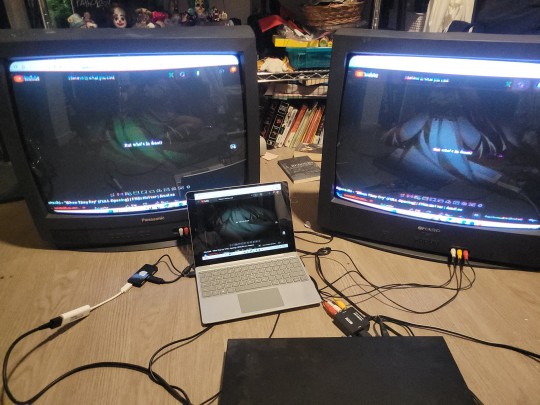
here is the setup, this is a multi monitor setup but you can just do this with one CRT.
step one: plug in your crt. cord in the back. that will power your crt!
step two: plug in the RCA cables like this.
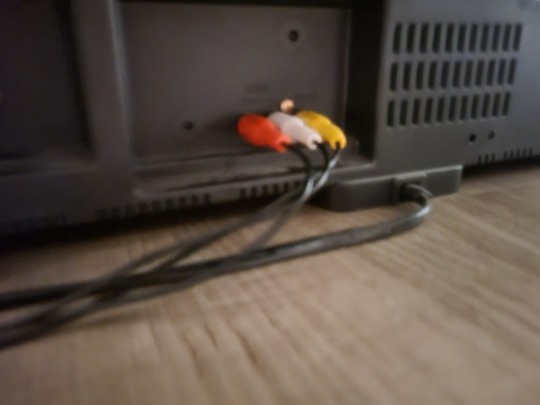
step three: plug your RCA cords into the HDMI2AV adapter like so. you'll plug in an HDMI cord on the other side. MAKE SURE IT'S SET TO THE CORRECT SETTING. THERE'S NTSC AND PAL
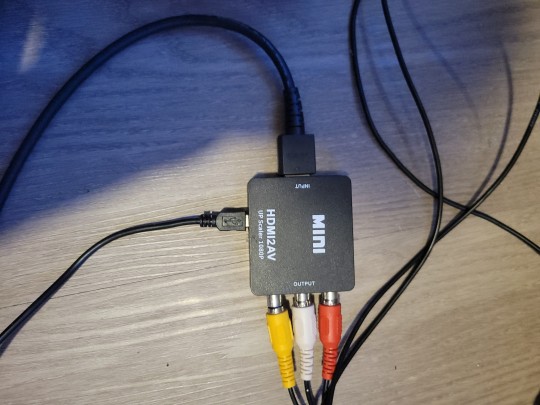
if you don't know what yours is, check this map that explains where each one was sold.
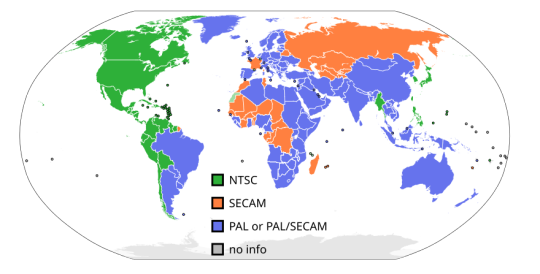
PAL is just a different color encoding system, a bunch of technical stuff you can learn on your own.
step four: plug your HDMI into the USB adapter if you need it. YOU MIGHT NOT. DEPENDS ON YOUR DEVICE.
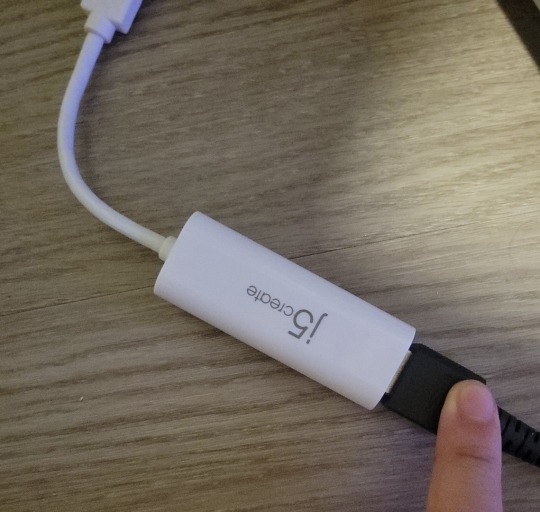
i use a windows surface pro and it requires i use this adapter. sucks ass but whatever.
OPTIONAL: if you have ONLY ONE usb port in your computer, consider getting a USB splitter so you can plug multiple things in. i have one.
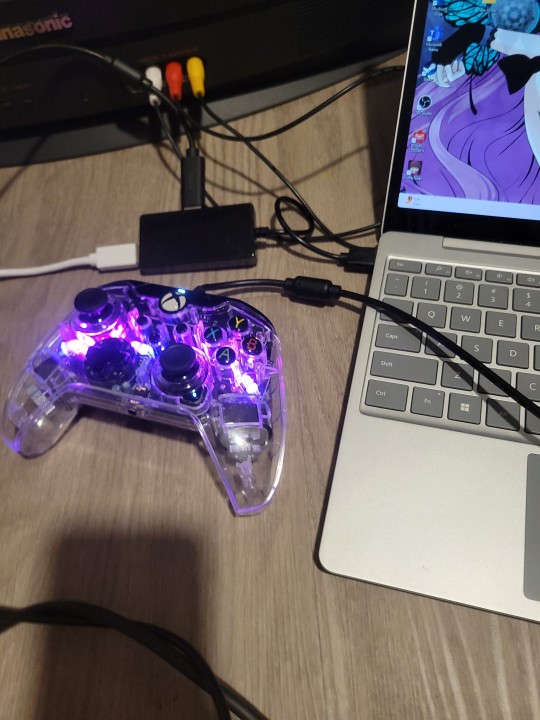
and voila. a set-up!

you can treat these like different displays.

mines connected by the 3 cords in the front, but if you have more money and can get another adapter and etc etc, you can make these all different.
a few FAQ since i assume quite a few of you have never used crts or vhs players:
whats the ringing sound?: its a ringing sound caused by the transformer in the back, its the 15kHz tone. as you get older, you stop hearing it because you lose high frequency hearing. i cant hear it in one ear because of a radio accident and i bursted my eardrum.
can i stop the ringing?: buy a crt pc. theyre smaller and dont ring as much/at all depending on which one you have.
how do i use my vhs player: you plug the cords into the back of the vhs player and then into the crt.
where do i buy a crt: theyre not in production anymore so you will have to buy it secondhand on markets.
where did you get all your cords: most stores with an electronics section will have it but consider secondhand computer parts store.
what do you do with it: literally watch YouTube, vhs tapes, make vhs tapes (whole different thing) or play video games.
can it run bad apple?: yes
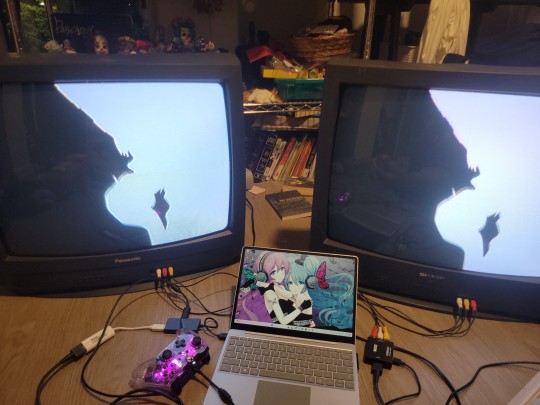
can it run doom?: yes

anyways yeah. end tutorial. 🥳
23 notes
·
View notes
Note
I've been playing Yakuza 2 for PS2 in Japanese and today I learned Daigo's idle animation when visiting Omi HQ with Kiryu has him tapping his right foot. Incessantly. This idle animation didn't make it into Kiwami 2 and I think the world needs to know this.
i have new motivations to get an RCA-to-HDMI cable and yakuza 2 for the ps2
#snap chats#PLEAAASSE I NEED TO SEE THAT#he's so impatient ...... boy if you dont wait five minutes .... sonic the hedgehog ass behavior#crying at the idea if you wait around too long daigo just leaves JEVLKARJ
20 notes
·
View notes
Text
In addition to yesterday being PTO from work, I took today and tomorrow off too. As fall approaches I usually like to set aside a few weekdays to wash windows and purge the house of unneeded items.
This morning I blasted through my home office, going through every drawer and cabinet. I found an old Garmin watch that I haven't used in years. It may still work, but it's large and clunky. The heart rate monitor is a separate strap that goes around the chest. It never felt comfortable to me.
These things wouldn't fetch a dime on eBay. I ran many miles and races with that watch. There are many nice memories around its worn-smooth, sweat-etched edges.
But I'll never use it again. My latest Garmin, like Hugh Hefner's youngest wife, is thinner, lighter, and does more things than the old one.
There's no point in keeping that old watch only to have my kids throw it away when I'm gone. I may as well benefit now having a desk drawer that isn't overflowing with junk/memories.
I also threw out of miles of cables and cords. Those RCA cables that connected my dual tape deck, turntable, and CD player to the cool Sony receiver I bought when I got married? Well, since I don't have any of those components anymore is there really any reason to keep the cables? Uh, no. Does anyone need a charging cord from a 1998 Palm Pilot? I have one, at least until the garbage truck arrives today.
It relaxes me, being able to see the bottom of drawers or having cabinets that close without a solid nudge from my shoulder.
Those clean windows make rooms a lot brighter as well.
54 notes
·
View notes